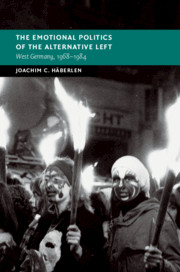69 results
Blue justice: A review of emerging scholarship and resistance movements
-
- Journal:
- Cambridge Prisms: Coastal Futures / Volume 1 / 2023
- Published online by Cambridge University Press:
- 26 January 2023, e15
-
- Article
-
- You have access
- Open access
- HTML
- Export citation
Diode-pumped, electro-optically Q-switched, cryogenic Tm:YAG laser operating at 1.88 μm
-
- Journal:
- High Power Laser Science and Engineering / Volume 9 / 2021
- Published online by Cambridge University Press:
- 23 March 2021, e11
-
- Article
-
- You have access
- Open access
- HTML
- Export citation
Ten new insights in climate science 2020 – a horizon scan
-
- Journal:
- Global Sustainability / Volume 4 / 2021
- Published online by Cambridge University Press:
- 27 January 2021, e5
-
- Article
-
- You have access
- Open access
- HTML
- Export citation
OP447 Feasibility And Validity Of Real-World Data As Evidence Of Effectiveness - Experience From Breast Cancer Care In Scotland
-
- Journal:
- International Journal of Technology Assessment in Health Care / Volume 36 / Issue S1 / December 2020
- Published online by Cambridge University Press:
- 28 December 2020, pp. 9-10
-
- Article
-
- You have access
- Export citation
Mature and immature platelets during the first week after birth and incidence of patent ductus arteriosus
-
- Journal:
- Cardiology in the Young / Volume 30 / Issue 6 / June 2020
- Published online by Cambridge University Press:
- 28 April 2020, pp. 769-773
-
- Article
-
- You have access
- Open access
- HTML
- Export citation
Feeling at home in lonely cities: an emotional history of the West German urban commune movement during the long 1970s
-
- Journal:
- Urban History / Volume 48 / Issue 1 / February 2021
- Published online by Cambridge University Press:
- 30 August 2019, pp. 143-161
- Print publication:
- February 2021
-
- Article
- Export citation
In situ TEM Approaches to Controlling the Growth of Semiconductors on 2D Materials
-
- Journal:
- Microscopy and Microanalysis / Volume 25 / Issue S2 / August 2019
- Published online by Cambridge University Press:
- 05 August 2019, pp. 1424-1425
- Print publication:
- August 2019
-
- Article
-
- You have access
- Export citation
Modeling of the 3D spatio-temporal thermal profile of joule-class
 $\text{Yb}^{3+}$-based laser amplifiers
$\text{Yb}^{3+}$-based laser amplifiers
-
- Journal:
- High Power Laser Science and Engineering / Volume 7 / 2019
- Published online by Cambridge University Press:
- 23 July 2019, e42
-
- Article
-
- You have access
- Open access
- HTML
- Export citation
(Not) Narrating the History of the Federal Republic: Reflections on the Place of the New Left in West German History and Historiography
-
- Journal:
- Central European History / Volume 52 / Issue 1 / March 2019
- Published online by Cambridge University Press:
- 27 March 2019, pp. 107-124
- Print publication:
- March 2019
-
- Article
-
- You have access
- HTML
- Export citation
Pheromone emission patterns and courtship sequences across distinct populations within Anastrepha fraterculus (Diptera-Tephitidae) cryptic species complex – CORRIGENDUM
-
- Journal:
- Bulletin of Entomological Research / Volume 109 / Issue 3 / June 2019
- Published online by Cambridge University Press:
- 15 January 2019, p. 418
-
- Article
-
- You have access
- HTML
- Export citation
Pheromone emission patterns and courtship sequences across distinct populations within Anastrepha fraterculus (Diptera-Tephritidae) cryptic species complex
-
- Journal:
- Bulletin of Entomological Research / Volume 109 / Issue 3 / June 2019
- Published online by Cambridge University Press:
- 29 November 2018, pp. 408-417
-
- Article
- Export citation
Contents
-
- Book:
- The Emotional Politics of the Alternative Left
- Published online:
- 20 September 2018
- Print publication:
- 20 September 2018, pp v-v
-
- Chapter
- Export citation
Introduction
-
- Book:
- The Emotional Politics of the Alternative Left
- Published online:
- 20 September 2018
- Print publication:
- 20 September 2018, pp 1-29
-
- Chapter
- Export citation
Chapter 1 - Wholeness and Exuberance
-
- Book:
- The Emotional Politics of the Alternative Left
- Published online:
- 20 September 2018
- Print publication:
- 20 September 2018, pp 30-75
-
- Chapter
- Export citation

The Emotional Politics of the Alternative Left
- West Germany, 1968–1984
-
- Published online:
- 20 September 2018
- Print publication:
- 20 September 2018
Copyright page
-
- Book:
- The Emotional Politics of the Alternative Left
- Published online:
- 20 September 2018
- Print publication:
- 20 September 2018, pp iv-iv
-
- Chapter
- Export citation
Chapter 4 - Searching for Intimacy
-
- Book:
- The Emotional Politics of the Alternative Left
- Published online:
- 20 September 2018
- Print publication:
- 20 September 2018, pp 167-221
-
- Chapter
- Export citation
Conclusion
-
- Book:
- The Emotional Politics of the Alternative Left
- Published online:
- 20 September 2018
- Print publication:
- 20 September 2018, pp 265-274
-
- Chapter
- Export citation
Index
-
- Book:
- The Emotional Politics of the Alternative Left
- Published online:
- 20 September 2018
- Print publication:
- 20 September 2018, pp 304-310
-
- Chapter
- Export citation
Chapter 2 - Feelings against Reason
-
- Book:
- The Emotional Politics of the Alternative Left
- Published online:
- 20 September 2018
- Print publication:
- 20 September 2018, pp 76-122
-
- Chapter
- Export citation






